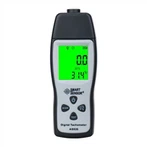Use and precautions for clamp ammeters
1. Safety first: When using the ammeter, safety must come first. When wiring and operating, the circuit should always be disconnected.
2. Choose the right ammeter: choose the right ammeter according to the range of current to be measured. If the current exceeds the range of the ammeter, it may cause the ammeter to burn out.
3. Pay attention to the measuring range: Make sure the current to be measured does not exceed the range of the ammeter, so as not to cause measurement error or burn out the ammeter.
4. Good contact: Make sure the wiring of the ammeter is firm and in good contact with the circuit to reduce the measurement error.
5. Avoid excessive current: Avoid generating excessive current when measuring current, otherwise it may lead to inaccurate measurement results.
6. Pay attention to the sensitivity: the sensitivity of the ammeter is the smallest division value under the minimum range. Suitable sensitivity should be selected according to the need to ensure the accuracy of measurement.
7. Avoid vibration and overload: the ammeter should avoid vibration in the process of using, so as not to damage the pointer or cause measurement error. And the use of ammeter should be avoided to exceed the endurance range of ammeter, so as not to cause overload.
Maintenance and care of ammeter
In order to keep the ammeter working normally and measuring accurately, it needs to be maintained and serviced regularly.
1. Regular calibration: the ammeter may produce error after using for a period of time, it should be calibrated regularly to ensure the accuracy of measurement.
2. Prevent water ingress: The ammeter should avoid contact with water to prevent damage or error.
3. Prevent vibration: The ammeter should be protected from vibration during use or storage to prevent damage to the pointer or errors.
4. Keep dry when not in use: when not in use for a long time, the ammeter should be kept in a dry place to avoid moisture.






